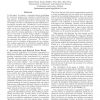244 search results - page 4 / 49 » On the Tightness of the Buhrman-Cleve-Wigderson Simulation |
IJON
2007
13 years 5 months ago
2007
Despite a steady improvement of computational hardware, results of numerical simulation are still tightly bound to the simulation tool and strategy used, and may substantially var...
WSC
2001
13 years 7 months ago
2001
Recent advances in low-power embedded processors, radios, and micro-mechanical systems (MEMs) have made possible the development of networks of wirelessly interconnected sensors. ...
DATE
2008
IEEE
13 years 7 months ago
2008
IEEE
In this paper, we propose a simulation-based methodology for worst-case response time estimation of distributed realtime systems. Schedulability analysis produces pessimistic uppe...
CORR
2004
Springer
13 years 5 months ago
2004
Springer
We study the simultaneous message passing model of communication complexity. Building on the quantum fingerprinting protocol of Buhrman et al., Yao recently showed that a large cl...
MEMOCODE
2003
IEEE
13 years 11 months ago
2003
IEEE
In this paper, we present a technique for determining tight bounds on the execution time of assembler programs. Thus, our method is independent of the design flow, but takes into...

